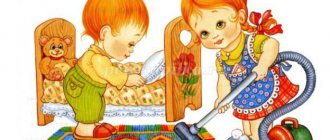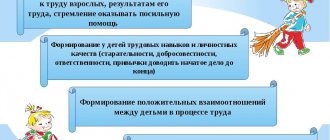This is the question of the future of any nation
It is very important to provide children with a decent childhood and help them get a decent job in the future, that is, work that benefits society and helps a person maintain a decent existence. Putting children in work that destroys their self-esteem, harms their health, morals and deprives them of educational opportunities seriously undermines the economic viability of a society and its long-term prospects for development.
Child labor must be seen not only as a cause, but also as a consequence of poverty and underdevelopment. Children engaged in the worst forms of child labor without even a basic education are likely to develop into illiterate, physically and intellectually disabled adults with little opportunity to escape the poverty they were born into and unable to contribute to development of society as a whole. Just like they themselves and their children will have very little chance of further development. In the current competitive world, the prosperity of any state fundamentally depends on the quality of its human resources; Tolerance of the worst forms of child labor prevents significant investment in human capital, which is the task of any society thinking about its future.
Even if it were possible to obtain short-term economic benefits from the use of child labor, they must be assessed against the background of the long-term losses in the development of the nation that these benefits entail.
Documents required when applying for a job
To get a teenager to work you need:
- document confirming the identity of the person entering the organization (general civil passport);
- confirmation of education, receipt of a certain qualification or certificate of suspension of education;
- work book (if available);
- document of a participant in the pension system (SNILS), except for the situation of hiring for the first place of work;
- confirmation of military registration (for boys);
- permission of the parent (guardian), as well as the guardianship authorities, to employ a child under 16 years of age;
- medical certificate.
The procedure established by the Ministry of Health and Social Development of the Russian Federation (Order No. 302, 04/12/2011) provides for the mandatory medical examination of adolescents every year until they reach adulthood.
Attention! A medical examination of a citizen is carried out at the expense of the enterprise (Articles 69, 266 of the Labor Code of the Russian Federation). If a minor employee does not have a medical certificate, the management of the organization faces liability for an administrative violation (Article 5 of the Code of Administrative Offenses of the Russian Federation).
Documentation on labor protection in preschool educational institutions
Remember that it is important to document all actions aimed at complying with current labor laws. Therefore, the head of the preschool educational institution must also ensure that the institution has the following mandatory documents on occupational safety:
- orders and instructions on the appointment of persons responsible for organizing certain labor protection processes;
- occupational safety instructions (for positions and professions; by type of work; when operating equipment);
- occupational safety magazines;
- regulations (regulations on occupational safety and health standards, regulations on occupational safety training, regulations on the issuance of personal protective equipment, regulations on investigation of NS, etc.);
- training programs;
- occupational safety training programs (for positions and professions; by type of work);
- training protocols for employees of the labor protection institution and training certificates for responsible persons;
- personal cards for issuing PPE and issuing flushing and (or) disinfectants;
- lists of labor protection;
- occupational safety action plan for the current year.
You can read more about this in our article What labor protection documents should be in every preschool educational institution.
Methods of labor education
There are several groups of methods:
- Methods of forming consciousness, used to form views, ideals, beliefs, attitudes. They contribute to the formation of feelings and moral experiences. Methods of personality formation are methods of persuasion: they convince the child of the correctness of actions, allow him to understand the need for work as an obligatory part of society . Persuasion can be achieved using methods: stories, explanations, suggestion, instruction, example, conversations;
- Methods of organizing socially significant activities allow the child to understand the role of his work and the benefits it brings;
- Stimulation methods: proper encouragement or punishment, competition. Approval from adults is always important; as a result, the child can experience inner satisfaction, the realization that he has achieved success in completing the task. Blame is also important.
Means of labor education for children
The choice of methods depends on the goals and objectives, the individual characteristics of the individual child, and the level of work readiness.
Legislation on labor protection in preschool educational institutions
Work on occupational safety in preschool educational institutions must be carried out strictly in accordance with the regulations of the Russian Federation, which include:
- Labor Code of the Russian Federation dated December 30, 2001 N 197-FZ.
- Resolution of the Ministry of Labor of Russia, Ministry of Education of Russia dated January 13, 2003 N 1/29 “On approval of the Procedure for training in labor protection and testing knowledge of labor protection requirements for employees of organizations.”
- Federal Law of December 28, 2013 N 426-FZ “On special assessment of working conditions.”
- Resolution of the Ministry of Labor of Russia dated October 24, 2002 N 73 “On approval of the forms of documents necessary for the investigation and recording of industrial accidents, and provisions on the features of the investigation of industrial accidents in certain industries and organizations.”
- Order of the Ministry of Health and Social Development of Russia dated 03/01/2012 N 181n “On approval of the Standard List of measures annually implemented by the employer to improve working conditions and safety and reduce levels of occupational risks.”
- Order of the Ministry of Health and Social Development of Russia dated June 1, 2009 N 290n “On approval of intersectoral rules for providing workers with special clothing, special footwear and other personal protective equipment.”
- Order of the Ministry of Health and Social Development of Russia dated December 17, 2010 N 1122n “On approval of standard standards for the free distribution of flushing and (or) neutralizing agents to workers and the labor safety standard “Providing workers with flushing and (or) neutralizing agents.”
Responsibility for labor protection in kindergarten
In accordance with Art. 212 of the Labor Code of the Russian Federation, responsibility for ensuring safe conditions and labor protection in preschool educational institutions rests with the head. It is clear that with a large number of personnel on staff, the director of a kindergarten cannot always find time to complete this work. Therefore, he can delegate some of the issues regarding the organization of labor protection to responsible persons. To do this, it is necessary to issue an appropriate order. The responsible persons, as a rule, are the deputy heads (for administrative and chemical work, administrative and chemical management, water management, and labor management) and a labor protection specialist.
Forms of labor education
Even Makarenko A. was looking for forms of organization that contributed to the formation of a developed and purposeful personality. The main idea of his system was education through labor in the team and through the team. Not everyone knows what form was proposed by Makarenko for the effective education of the younger generation. This form became a combined detachment, which received a modern continuation in the form of squads and volunteer detachments.
All forms aimed at developing hard work are combined into several groups:
- Individual (fulfillment of orders, individual tasks and requirements);
- Collective (socially useful type of work) is aimed at the child’s adaptation in society and the team;
- Group (holidays, matinees, competitions).
There are many forms of education. They are subject to certain conditions. The most popular forms: individual assignments, various types of social work (volunteer teams, shifts, holidays, cleaning, landscaping, landscaping, repairing furniture and textbooks).
Effective forms of developing the right personal attitude towards work are:
- work in units to perform work;
- development of labor traditions;
- shows, exhibitions, competitions;
- detachments and labor landing;
- individual orders.
The labor education system uses the maximum possible number of forms to ensure the education of responsibility, hard work, organization, and collectivism in the younger generation.
Forms of work with preschoolers
The number of forms for preschool children is also quite large. They are distinguished by their simplicity and at the same time invaluable power in educational impact. The most used forms in preschool education:
- Assignments (individual, group and general; short-term, long-term);
- Duty - organization of activities that involve work to serve oneself and the children's team;
- Collective, joint activity is the activity of a group of children united by one goal.
Creativity can also be called one of the forms of developing labor qualities in a preschool educational institution.
Organization of work activities of preschool children
Work activities throughout preschool childhood become more complex, covering the path from mastering self-service skills to performing household duties and caring for plants and pets.
At 3-4 years old, even brushing your teeth or getting dressed for a walk on your own is difficult. With the development of manual skills, children's self-service skills are automated and move from the category of “work” into everyday actions. The work activity of a preschooler is filled with other processes involving the development of tools and the achievement of results.
The uniqueness of the work activities of younger preschoolers
It is clear that a 3-year-old child will persistently demand to be allowed to test in the kitchen in order to “help” make pies. But his interest will dry up in response to an offer to tidy up the gaming corner of his room.
The main reason is the lack of novelty, and therefore the lack of excitement in the process. Other, no less important reasons are added to it. The kid may simply not understand how to restore this very order...
In early preschool age, in order to introduce a child to work that is feasible for him, it is important to give specific and understandable instructions. “Put the cubes in a box, put the box on the shelf”, “Put your socks in a drawer” - after hearing such instructions, the baby will understand what they want from him at the moment, and will also gradually form a sequence for putting things in order.
Clear instructions are an essential element in developing a preschooler’s work skills.
Only by mastering the rules that allow him to organize his work will a preschooler be able to independently initiate and complete everyday work activities in the future.
Labor in older preschool age
Older preschoolers are introduced to work not for the sake of participation. Although there are also cases when 6-7 year old children are driven solely by curiosity: “How do you spin that? Let me try.” “I also want to dig” - the child takes up a shovel, but after a few attempts he loses the desire to do something that is quite physically difficult.
However, in most cases, all components of work activity can be traced in the activities of preschoolers: motive, goal, actual actions, control and evaluation . That is, the child sees the goal for applying his efforts, chooses the means, how he can get the result, performs the actions and is interested in the result of his work.
For example, 5-year-old Masha reports that she wants to sweep the room “to make it clean.” Having at least practiced with a broom, she collects the garbage in a dustpan and immediately asks if she swept well. Although the girl relies solely on praise for her efforts, she is interested in achieving her goal.
Mastering the components of work activity contributes to the development of the personal qualities of a preschooler. There is a direct influence on the formation of the following qualities:
- hard work
- responsibility
- independence
- perseverance
- criticality
Older preschoolers evaluate their work more objectively. They notice, unlike younger children, gross shortcomings and try to correct them. But it is important to them how an adult evaluates the quality of their work actions, so they ask appropriate questions.
Thanks to the development of speech, children in older preschool age are well able to perceive verbal instructions on how to perform a certain task. Adults will help the child if together they discuss the sequence of steps that will lead to the desired result.
CONDITIONS OF CHILDREN'S LABOR ORGANIZATION
Solving the problems of labor education is carried out subject to a number of conditions: the systematic inclusion of each child in work, taking into account the load on the child, taking into account the individual preferences of the child in combination with the principle of compulsory work, selection of equipment for work, and the creation of a working atmosphere in the group.
6.1. SYSTEMATIC INCLUSION OF EVERY CHILD IN WORK
The systematic inclusion of a child in work ensures the formation of the habit, and then the need to work. The child gets used to this type of activity, improves labor actions and increasingly performs them automatically or more confidently.
Becoming habitual, work actions turn into skills and abilities, and the child becomes more independent, independent of the adult, and bolder in taking on new tasks.
Children’s participation in work is achieved in different ways: in the process of carrying out assignments, duties as an attendant in classes, in a corner of nature. Of course, self-care work requires constant labor effort from the child. It is important to systematically include manual, household labor in various forms, organized by the teacher, into the child’s life regimen. This creates natural conditions for the inclusion of each child in different types of work and forms of its organization.
In order for all children to be involved in work, the teacher should plan this work, plan in advance which of the children to give what assignment, how to line up the duty, etc., plan weekly in a group or in a section for general, joint or collective work.
6.2. ACCOUNTING THE CHILD'S LOAD
The work of children, of course, does not replace the work of adults. The child participates in the work of adults and performs some part of the work available to him.
The teacher, organizing the work of children, evaluates it not so much by the volume of work done, but in relation to the work, the manifestation of responsibility, conscientiousness, and the ability to complete the task.
During work, the child faces stress. This is natural, since the essence of labor is effort, load, tension. Insufficient load makes work too easy and does not require effort. The child gets used to working without effort and therefore subsequently does not want to accept work tasks that require effort.
At the same time, excessive load also has a negative effect. Overload causes overwork and the appearance of a negative attitude towards work.
Children relate to stress differently. Thus, children who cannot yet determine in advance the degree of load can take on a very large load, but, of course, cannot complete it. S. N. Teplyuk conducted a study on teaching young children to work. One of the tasks was to determine the permissible load. The researcher conducted the following experiment: children were asked to move sand into a sandbox. They had to choose a bucket themselves, pour sand into it and carry it. As a rule, all children aged 2.5 to 3 years old took the largest bucket, poured sand into it to the top and tried to carry it. Did not work. They refused to take a small bucket (they are already “big”!). Then the researcher offered the children the same large buckets, but different ones. The children poured sand into them to the top, not paying attention to the fact that it was filled to the top much faster than before, and with little effort they completed the task. They were happy. What's the matter? The fact is that the second time they were offered buckets with a double bottom and much less sand went in, but the child’s “I-myself” was not infringed. Gradually, as the skill was mastered and with the increase in the age and physical strength of the children, the bucket became more “capacious”, the second bottom decreased, and the child could carry sand, confident in his abilities, but without overload.
The greatest amount of physical stress is felt when children are clearing snow or digging up soil in the garden. It is very important to teach children this work. The teacher must show how much snow can be taken on a shovel, how high to lift it, how to throw snow on the side of the path, or how to shovel snow to one place. An adult is always close to the children and monitors the fulfillment of such conditions so that the children work with a workload that is appropriate for their age. An adult must remember that only freshly fallen snow can be shoveled with children.
There are also rules for digging up soil. And children should first be familiarized with them: children dig up only loose soil, take the shovel correctly, do not dig deep, turn the shovel over with the soil without lifting it high.
The teacher monitors the pace of work: the pace can be either too slow or too intense. Both are bad. A moderate pace prolongs children's working capacity and delays fatigue. It is important to take into account the characteristics of children and guide the process of completing the task. When organizing joint, collective work, you can allow a change in the nature of the work after 5-8 minutes: first, one child washed the toys, and the other wiped them, and then the children swapped responsibilities. Fatigue did not set in and interest in work activities increased.
6.3. SELECTION OF WORK EQUIPMENT
First of all, it should be remembered that work equipment and toys representing work equipment are different things with different purposes. Only color can unite them - bright, attractive to a child. Equipment for work (shovels, rakes, brooms, watering cans, etc.) must correspond to the height of the child, but be such that the child can perform a work action, not a play action, i.e., for example, not as if he was digging up the ground, and dug it up as necessary for subsequent use in . planting plants.
There should be enough equipment for work for all the children in the group so that the teacher can organize common work, giving the children different work assignments, but at the same time. If children have to wait until the equipment is free, then they gradually lose interest in work and there is no longer any need to talk about labor education.
It is important to think about how and where to place work equipment. It should always be in the same place, which the children know about and in which they always place the equipment after work. It could be a shelf, a closet, a specially designated place, etc., but it is always the same. Equipment must be clean and always ready for children to use in their work. Therefore, children should immediately be taught to wipe equipment after use. It is not at all necessary to have all the equipment in plain sight; it is important that children know where it is and can take it independently if necessary.
6.4. CREATION OF A WORK ATMOSPHERE IN THE GROUP
One of the important conditions for labor education is the creation and maintenance of a working atmosphere in the group. The need for work arises constantly: putting away toys after playing, watering indoor plants, putting things in the closet after a walk, putting chairs in place, etc. Children are taught to notice problems and correct them themselves. The teacher constantly shows children an example of such an attitude towards the environment. This does not mean that he corrects problems himself, he does it together with the children, gives them instructions, draws their attention to the result, teaching the children to the order that they themselves, together with the teacher, maintain in the group.
The teacher always emphasizes how good it is when the group is clean, all things are in place after use. How pleasant it is to live in such a group! It is very important to carry out similar work with parents, involving them in ensuring that children do not leave their things at home and help parents in cleaning the apartment. Such joint work of adults will help to strengthen in children the habit of living in a neat, beautiful environment and working for it.
Such a work atmosphere should not be burdensome for children, it should not limit their desire to play, draw, or engage in any other activity that interests them; it should be natural for the child and perceived as a necessity. Children should experience joy from work, therefore, when common work is organized, you can turn on quiet music that is pleasant for children. When a child carries out individual assignments, he should feel a sense of responsibility and importance from the task assigned to him; when children are on duty, they do it with a feeling of joy, as they are doing pleasant and necessary work for their comrades. It’s good if the teacher, in the process of organizing work, does not forget to remember a proverb, a saying that will cheer up the child (“Patience and work will grind everything!”, “It’s a hard day until the evening, when there is nothing to do!”).
Accustomed from childhood to living in a good working atmosphere, the child will not perceive labor actions as a heavy, unwanted duty, but will accustom himself to perform labor duties easily and with an understanding of their necessity.
6.5. ELEMENTS OF CREATIVITY AND FREEDOM IN THE CHOICE OF LABOR ACTIONS
An important condition for organizing work is stimulating children to be creative. Of course, work is a mandatory activity, often based on the precise execution of labor actions. But at the same time, it’s more interesting to work if you can bring something of your own into these actions, improve something, rationalize something, if you use elements of experimentation, if you solve a work problem with the help of mental labor.
So, the teacher invites the children, while on duty for classes, to decide for themselves how the people on duty will lay out the pencils - the whole set for each child at once, or one person on duty will lay out red pencils for everyone, and the other - green ones. At the same time, the children themselves determine how they will work today. This arouses their interest, creates a kind of game situation, and the children complete the task with pleasure. The teacher observes the children, and then, after the end of duty, can talk with those on duty about which form of completing the task seemed more rational and quick to them. Let the children analyze the chosen method themselves and make a decision.
The teacher asks the children to arrange the toys in the toy corner so that it is convenient for all children to take the toys. This can be done in different ways: you can do it traditionally, or you can switch something around. Even if the option chosen by the children is not very correct from the position of the teacher, there is no need to immediately tell the children about this; they themselves will draw the necessary conclusion later.
By offering children joint work to clean the room, they are given the opportunity to determine for themselves what materials will be needed for the work, where to get them, who will take them, decide where to start the work, etc.
Such freedom of choice creates in children a feeling of trust in them, and they also acquire the practice of performing the same work in a variety of ways, which makes the work more attractive, independent and responsible.
The content of any child labor can include situations for the manifestation of creativity, invention, and making one’s own decisions. It is only important to discuss their actions with children, ask them to explain the reason for the chosen decision, analyze the results and the effectiveness of the methods of completing the task. Such performance of work tasks and their subsequent discussion makes work meaningful, independent and brings joy to the child.
QUESTIONS AND TASKS FOR SELF-CONTROL
1. Explain how the conditions for organizing children’s work affect the effectiveness of solving problems of labor education.
2. How are taking into account the load on the child and the choice of equipment for work related?
3. What features of children’s age are important to consider when creating conditions for creativity and freedom in choosing work actions?
4. What other conditions for organizing the work of children could you offer?
Briefings
In kindergartens, it is mandatory to provide instructions on occupational safety (Article 212 of the Labor Code of the Russian Federation). The head of the institution is prohibited from allowing employees who have not completed their duties to perform their official duties.
The types of briefings, the procedure and requirements for organizing them by the employer are established by Resolution of the Ministry of Labor of the Russian Federation and the Ministry of Education of the Russian Federation dated January 13, 2003 N 1/29 “On approval of the Procedure for training in labor protection and testing knowledge of labor protection requirements for employees of organizations.”
Let's look at the main types of safety training.
| Type of instruction | Who is it for? | In what cases is it carried out? | Conducted by whom |
| Induction training | To all employees. | When applying for a job. | Manager / occupational safety specialist. |
| Initial briefing | To all employees. Exception: employees who are exempt from training by order of the head of the organization in accordance with clause 2.1.4. Resolution No. 1/29 of January 13, 2003 | When applying for a job. | The immediate supervisor of the work, appointed by order. |
| Re-briefing | To all employees. Exception: employees who are exempt from training by order of the head of the organization in accordance with clause 2.1.4. Resolution No. 1/29 of January 13, 2003 | Regularly, at least once every 6 months or at least once every 3 months, if the work involves increased danger and this requirement is established by industry labor protection rules. | The immediate supervisor of the work, appointed by order. |
| Unscheduled briefing | The list of employees is determined by order of the head of the organization. | At the request of supervisory authorities. After an emergency or accident occurs; When launching new equipment. When new labor protection requirements come into force. After a long production downtime. | The immediate supervisor of the work, appointed by order. |
| Targeted briefing | The list of employees is determined by order of the head of the organization. | When performing one-time work not related to direct job responsibilities. When eliminating the consequences of accidents and natural disasters. When performing work according to a work permit. When organizing mass events and excursions. | The immediate supervisor of the work, appointed by order. |
Why are instructions needed? First of all, to prevent the occurrence of dangerous situations and injuries during the performance of work duties. Kindergarten employees must know their areas of responsibility, and in the event of a dangerous situation, they must help teachers prevent injury to the young children entrusted to them.
All briefings end with an oral test of the knowledge acquired by employees.






